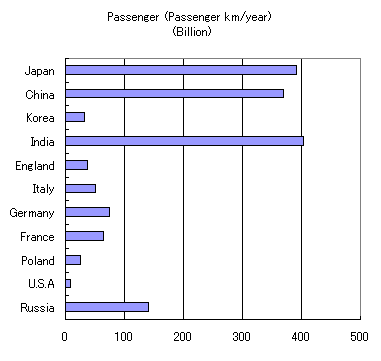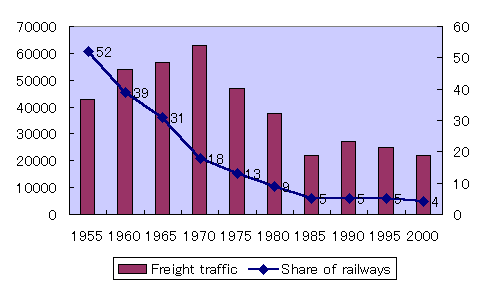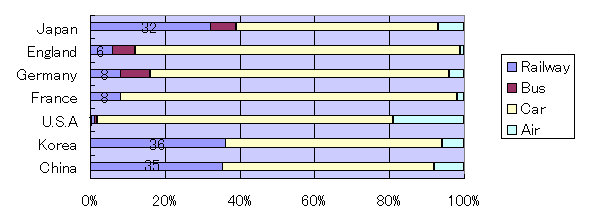Amount of rail traffic in Japan compared with major countries Passenger rail traffic in Japan is quite large, which is much larger than other industrialized countries. Most of traffic consists of Shinkansen, urban railways and subways around Tokyo and Osaka, and limited express trains between major cities. It is surprising that passenger kilometers of Japan railways are nearly same as India and China, which has more than five or ten times larger population and land area. Currently, Japan has the second largest passenger traffic in the world next to India. On the other hand, freight traffic of Japan railways is quite small. Freight trains run frequently in Tokaido and Sanyo line in midnight between Tokyo and Fukuoka freight terminal, and Tohoku, Hakodate line between Sumidagawa (Tokyo) and Sapporo freight terminal, and some services in Japan Sea coast line between Osaka and Sapporo freight terminal, but in other lines, number of freight services is so small or zero, even in the line limited express trains run frequently. It is quite unique that Japanese railways have much larger importance on passengers than freight. Situation is opposite in many countries. Consequently, passenger car traffic is not so large in Japan considering its mass population, but truck traffic is quite large. And main roads in large cities and highways between Tokyo and Osaka are occupied by trucks. |
|
Railway Length (km) |
Passenger (Passenger km/year) (Billion) |
Freight (ton km/year) (Billion) |
|
|
Japan China Korea India England Italy Germany France Poland U.S.A Russia |
202 576 31 625 171 161 375 317 244 2341 870 |
391 370 33 404 38 50 74 64 26 9 141 |
23 1231 10 282 18 23 71 55 55 2238 1205 |

|

|
|
Change of rail traffic and its share in Japan Next data shows the change of rail traffic and its share in all transports in Japan. Passenger traffic had increased till early 1970s, but decreased in late 1970s. It had increased again in 1980s and early 1990s, but decreased in late 1990s. In 1950s, share of rail was quite high, more than 80 per cent. At that time, rail facility was not very good, mainly slow track steam line train running single track line. But situation of other transports was even worse, many roads between major cities were unpaved and there was no highway at all. Air service was provided by small capacity aircraft and it was about ten times as expensive as railway. After that, railway was improved due to Shinkansen, double-tracking and electrification, but road and air advanced more rapidly extending highway network and large jet aircraft, and share of railways had kept decreased. In late 1970s, passenger traffic turned to decrease for the first time in Japanese railway history except severe era after the Second World War. It was due to debt of National railway and consequent raise of fare and stagnation of rail services besides development of other transports. In 1980s, National railway was reformed and privatized, and service was improved. Moreover, Japanese economy was in boom at that time, so rail traffic increased. In late 1990s, rail service is not so bad as in National railways era, but passengers again are decreasing. One reason is recession of Japanese economy, but the other is more severe competition between road and air traffic. Highway has been constantly extended and many national roads were built every year, while little public investment was done in railways in Japan. Air industry was recently deregulated and air services cheaper than rail are being introduced. Situation is different in the case of freight traffic. It peaked in 1970 and has declined after that except some years after privatization of National Railways in 1987. National railways suffered from debt drastically cut freight services which was unprofitable. In 1970s and 1980s, fast and direct services using freight container were improved, but many services using yard rearranging freight cars going different destination were abolished due to their cost and labor. Other reasons can be pointed out for quite low share of rail in Japanese freight traffic. Firstly, Japan is surrounded by sea and share of ferry is higher than many other countries. Secondly, distance of most freight traffic in Japan is relatively short, less than 500 kilometers, while railway freight, which costs more labor in loading but less burden in transporting than car, has advantage in long distance more than 1000 kilometers.   Share of rail traffic compared with major countries Share of passenger rail in Japan is much larger than all other advanced countries. Situation of motorization is not so different in rural area of Japan as in other countries, but Shinkansen and urban railway running densely populated areas are quite competitive. On the other hand, share of freight rail in Japan is the lowest in major countries shown in the graph. It is still declining and seems difficult to recover unless getting heavy public investment to railways considering effect of truck to environment and pollution, but Japanese Government still prefers road and air to railway, unfortunately. Railway companies in Japan are generally operated by the principle of self-supporting including management of infrastructures, unlike most railways in the world subsidized by the government. It has been possible because of high population density and active traffic demand, but it also has been the cause of the lack of investment to railways, compared with extending highway network and many airports.  Share of freight transport in major countries  |